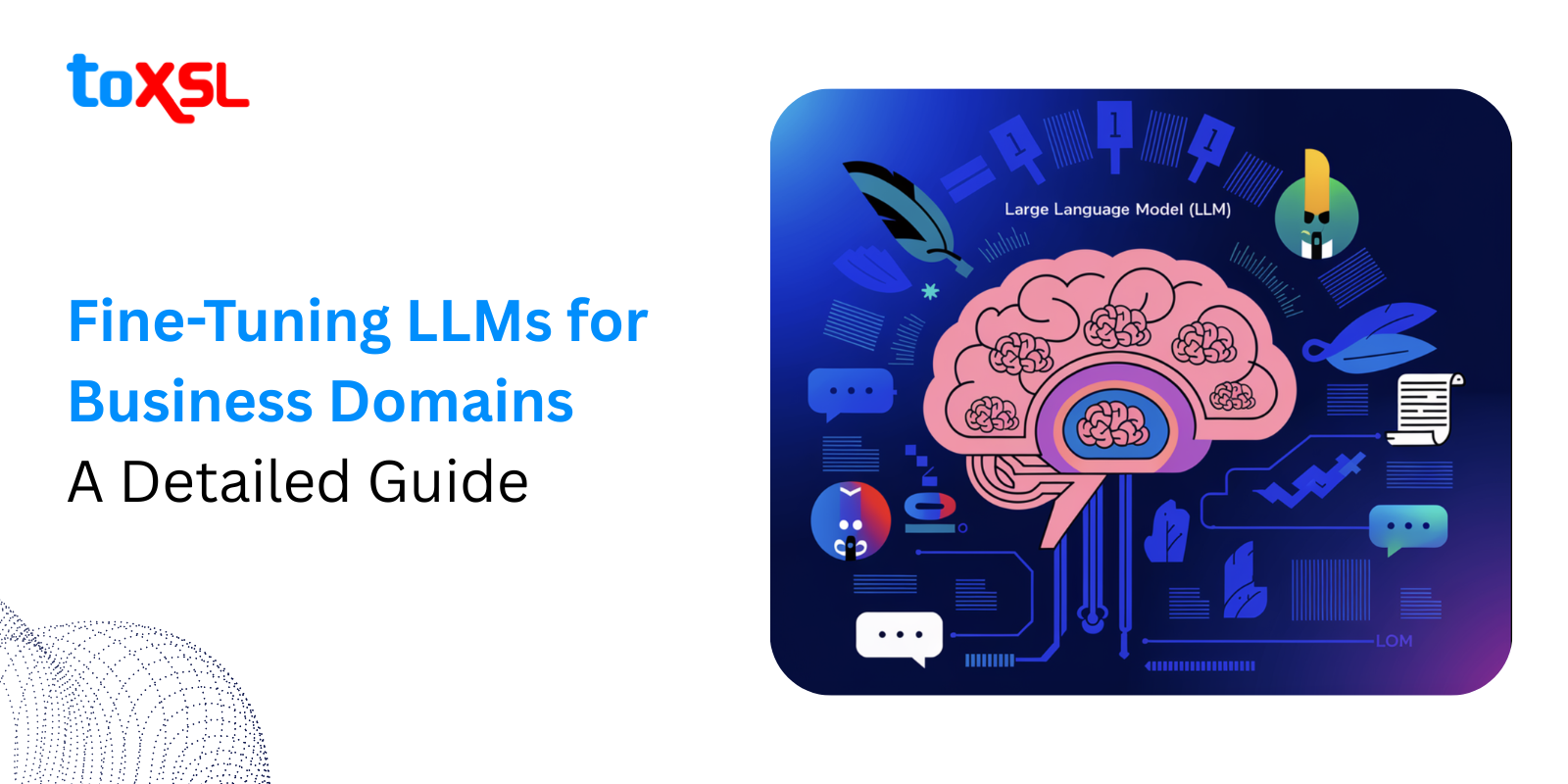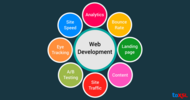- Jul 29, 2025
Share this post on:

Since the release of the “Attention is All You Need” paper, Large Language Models (LLMs) have gained lots of popularity all over the world. Models such as ChatGPT, Claude, and Cohere are helping businesses integrate LLMs into their tech stack. This surge in popularity of LLMs has developed huge demand for fine-tuning foundation models on particular data sets to ensure accuracy.
What is LLM Fine-tuning?
Model fine-tuning is a process of training a pre-trained model. A pre-trained model has already learnt patterns and features on a large dataset. LLM refers to a Large Language Model, such as the GPT series from OpenAI. Fine-tuning is crucial, as training large language models from scratch is expensive in terms of computational resources and time. Using what the pre-trained model has already learnt means you can achieve high performance on specific tasks with much less data and computing power.
Types of Fine-Tuning Large Language Models (LLMs)
Here are a few types of fine-tuning large language models (LLMs):
Unsupervised Fine-Tuning: This way doesn’t need any labelled data. Instead, the model reads a lot of unlabeled text from the area you want it to learn about, like legal or medical texts. This helps the model get better at understanding the language in that area. It’s good for general learning but not as sharp for specific tasks like sorting or summarizing.
Supervised Fine-Tuning (SFT): Here, the model is trained using labelled examples that match the task you want, like sorting texts into categories for business use. This works well but needs a lot of labelled data, which can take time and money to prepare.
Instruction Fine-Tuning with Prompt Engineering: This method uses clear, natural instructions to guide the model. It’s great for building special helpers or assistants and needs less labelled data. However, how well it works depends a lot on how good and clear the instructions (prompts) are.
Working Process of Fine-tuning Large Language Models
Fine-tuning is a process of improving large language models (LLMs) through transfer learning. It includes adjusting an LLM’s parameters with task-specific data, maintaining its original training knowledge. This allows models such as BERT or GPT-4 to do tasks more accurately. The fine-tuning process consists of two phases:
Preparation Process: Before using a pre-trained model for your special task, you need to prepare it. Here are the main steps:
Pick a Pre-Trained Model: First, choose a pre-trained model that fits what you need. These models have already learned a lot about language by reading a lot of text, so they have a good general understanding.
Decide on the Task and Get Your Data: Be clear about what you want the model to do. Then, gather the data that matches your task. This data should be organized or labeled so the model can learn properly.
Data Augmentation: Sometimes, you can improve the training by adding more variety to your data. This means creating new examples from your existing data to help the model learn better.
Fine-tuning Process: Fine-tuning is the next step, where we take the prepared model and teach it to do really well at the specific task you want. Think of it like training a student who already knows a lot to become an expert in one subject. There’s a picture below showing the main stages of fine-tuning. These stages can be split into smaller steps, but for now, let’s look closer at the whole process.
Dataset Preprocess: Start by cleaning your data—remove mistakes or useless bits. Then, split it into three parts: training data (to teach the model), validation data (to check how well it’s learning as you train), and test data (to see how well it works at the end). Making sure your data fits well with the model is very important.
Model Initialization: Take a powerful language model like GPT-3 or GPT-4 that already knows a lot from reading tons of text. This model is your starting point for fine-tuning.
Task-specific Architecture: Change or add some parts in the model so it’s better suited for your specific job. This way, it keeps all its general knowledge but becomes more focused on what you want it to do.
Training: Next, teach the model using your task data. The model adjusts itself step-by-step by learning patterns in the data, improving with every pass.
Hyper-parameter Tuning: Adjust settings like how fast the model learns (learning rate), how many examples it looks at a time (batch size), and others. This helps the model learn better and avoid mistakes like memorizing the data without really understanding it.
Validation: Keep an eye on how the model does on the validation data while training. This tells you if it’s learning well or just memorizing the training examples. You can make changes if things aren’t going well.
Testing: After training, see how the model performs on new, unseen test data. This shows if the model will work well in the real world.
Iterative Process: Fine-tuning usually takes a few tries. Based on test feedback, you might tweak the model, training settings, or data to get better results.
Early Stopping: If the model stops improving or starts doing worse on validation data, stop the training to avoid over fitting (which means it only works well on training data but not new data). This saves time and keeps the model smart.
Deployment: Once you’re happy with how it works, put the model into your app or service so it can do real tasks like writing, answering questions, or giving recommendations.
Add Security Measures: Protect your model and app by using strong security tools to stop hackers or misuse. Keep checking and updating security to make sure everything stays safe.
Steps to Choose the Best Pre-trained Model for Fine-tuning
Choosing the right pre-trained model is very important when working on language tasks. It can make your work easier and your results better. Let’s look at some simple steps to help you pick the best model that fits your needs:
Define Your Task: Start by deciding exactly what you want your fine-tuned model to do. Is it writing text, sorting it into categories, translating languages, summarizing long content, or something else? Being clear about your goal is very important.
Model Types: Get to know some common pre-trained models in language work, like GPT-3, BERT, RoBERTa, and others. Each is built a bit differently and works well for different kinds of jobs.
Understand Strengths and Weaknesses: Look closely at what each model is good at and what it struggles with. Some are better at understanding the meaning of context, other scan create smoother text, and some handle long documents better. Think about what matters most for your task.
Match the Model to Your Task Needs: Think about the special skills your task needs. For example, does it need a good understanding of context? Or should it be great at writing clear and related sentences? Maybe it has to work with long pieces of text. Pick the model that fits these needs best.
Conclusion:
Fine-tuning has become an important tool in LLM requirements for businesses to improve their operational processes. Are you looking to fine-tune large language models? ToXSL Technologies is here to help. Our artificial intelligence services, along with our model fine-tuning services, have helped numerous businesses expand. Want to learn more? Contact us today.
Frequently Asked Questions
1. What is fine-tuning an LLM, and why is it important for businesses?
Fine-tuning means taking a large pre-trained language model and training it further on a specific business-related dataset. This process helps the model perform much better on tasks important to your business, like understanding industry-specific terms or producing responses in your brand’s voice.
2. When should my business consider fine-tuning a language model?
Fine-tuning is useful if your business needs the model to handle specialized language or jargon, generate outputs in a consistent format, improve accuracy on specific tasks, or align with your brand’s style. It's also valuable to improve performance and reduce costs by tailoring the model closely to your use case.
3. How does fine-tuning improve model performance without needing huge amounts of new data?
Because the model already knows a lot from general pre-training, fine-tuning uses smaller, focused datasets from your business domain to teach it new specifics. This approach requires much less data and computing power than training a model from scratch but still yields powerful, customized results.
4. What are the main steps involved in fine-tuning an LLM for business use?
Key steps generally include preparing and cleaning your business-specific data, selecting a suitable pre-trained model, customizing or adding task-specific parts to the model, training with your data, carefully tuning learning settings (hyperparameters), validating and testing the model, and finally deploying it safely with security measures in place.
5. How do I choose the right pre-trained model for my business fine-tuning project?
Consider your task goals, model size, and architecture. Also, think about what kind of data the model was originally trained on, the technical resources you have, and the support or community around the model. Testing a few models on a sample of your task can help you pick the best fit.












